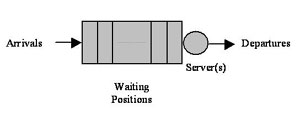Model of a Queue :

A queue represents a general service facility. Customers enter the system to get the desired service from a server (there may be one or more servers) and then leave the queue once service has been provided. Customers arriving when all servers are busy, wait for service until a server becomes available.
In real life, such a service facility can only have a finite number of waiting positions where customers (also called jobs) may wait for service to begin. In a queue representing a switch or a router in a computer network, this will typically be decided by the amount of buffer available. For modelling convenience or when the buffers are large, we can model the number of waiting positions to be infinity.
In order to study the performance of a queue through analysis or simulation, various details about it need to be provided. The important input specifications that are typically required are listed in the next slide.
Queue Specifications :
Input Specifications
• Arrival Process Description
• Service Process Description
• Number of Servers
• Number of Waiting Positions
• Special Queueing Rules, e.g. -
• order of service (FCFS, LCFS, SIRO, etc.)
• baulking, reneging, jockeying for queue position
The Arrival Process Description describes how customers/jobs arrive to the queue. This is typically specified as a stochastic (i.e. random) process. The Service Process Description specifies the manner in which service to a job is typically provided. The Number of Servers specify how many servers are available to service customers in the queue. Typically, all servers are identical to each other and any available (free) server may give the service required by a particular job. The Number of Waiting Positions specify the number of jobs which can wait in the system in case the server(s) are all engaged. Finally, we also need to specify the rules that will be followed in handling the queue. The Service Discipline may specify the order in which waiting customers will be served, e.g First Come First Served (FCFS), Last Come First Served (LCFS), Service in Random Order (SIRO) etc.. It may also specify some special rules on queue handling such as whether the queue will allow baulking or reneging.
Baulking happens when an arriving customer does not join the queue, i.e. possibly when it sees too many people waiting. Reneging happens when a customer who has joined the queue and is waiting for service, decides that it does not want service any more and leaves the queue.